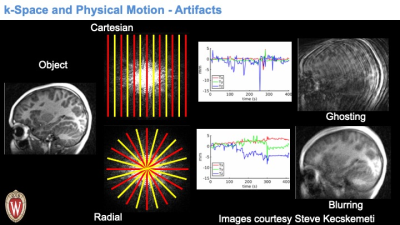Basic Theory of Motion Artifacts in MRI
1Medical Physics, University of Wisconsin - Madison, Madison, WI, United States
Synopsis
Motion artifacts are one of the most common causes of poor imaging quality in MRI. These artifacts related to the coupling between the spatio-temporal properties of the motion and the trajectory and timing of k-space measurements. This presentation will review the underlying mechanisms of motion artifacts in MRI.
Overview
MRI is a highly versatile non-invasive technique for generating high quality images of anatomy, physiology and function. The signal measurement is also highly sensitive to motion. In some applications like angiography and diffusion-weighted imaging, this sensitivity to motion produces useful information; however, in other applications, motion can lead to image errors and artifacts that diminish image quality and obscure critical information. Movement associated with blood and other fluid flow during the application of imaging gradients causes shifts in location and phase of the signal, which can lead to signal loss, spatial misregistration or ghosting artifacts. These flow artifacts may be mitigated by nulling the 0th and 1st order gradient moments. More broadly, the manifestation of image artifacts are a function of the type, amplitude & timing/frequency of physical movements in relationship to the timing and trajectories of the signal measurements in k-space. For standard Cartesian k-space sampling, motion will lead to inconsistencies across lines of k-space, which will result in blurring and ghosting artifacts in the phase encoding direction. Conversely, for radial k-space sampling, motion causes these signal variations to occur in the radial dimension, which will result in more regional blurring. This presentation will review the physics associated with flow and physical motion.Blood Flow Artifacts
Motion from blood flow is a common source of artifacts in MRI. In the presence of magnetic field gradients, phase is accumulated linearly with time for stationary spins; however, the temporal phase accumulation is quadratic for constant velocity flow. Further, the timing of image encoding gradient pulses in the readout, phase-encoding and slice-encoding directions will result in differential temporal 'tagging' by various gradient pulses for moving spins and phase offsets during the signal readout. These phase errors will lead to spatial shifts in physical vessel location, signal loss for non-uniform (i.e., laminar, turbulent) flow, and ghosting for pulsatile flow. These flow artifacts may be mitigated by designing flow compensated gradient waveforms to null the zeroeth and first order gradient moments. Flow compensation can effectively minimize the phase offset at the center of the signal echo and minimize the artifactual displacements of blood vessels.Physical Motion Artifacts
Physical motion (translation, rotation, expansion/contraction, nonlinear) is also a common source of image artifacts in MRI. As the MRI signal is acquired in the k-space spatial frequency domain, the type of motion will lead to magnitude and phase signal changes in k-space. A translation (physical shift) of the object will lead to a linear phase shift in k-space. Object rotation will cause the signal to also be rotated in k-space. More complex motion will yield less predictable magnitude and phase changes in the k-space signal. The manifestation of the motion artifacts in the image will be modulated by the k-space sampling trajectories. Motion with Cartesian k-space sampling will lead to signal modulation in the phase encoding direction, which manifests as image ghosting. Motion with radial k-space sampling will lead to signal modulation in the radial dimension, which primarily causes image blurring. Overall, local spatial blurring is generally less objectionable than ghosting, thus radial trajectories are promising for applications where motion may be particularly problematic.Acknowledgements
No acknowledgement found.References
Ch 23. Motion Artifacts and Flow Compensation in Magnetic Resonance Imaging: Physical Principles and Sequence Design. by Brown RW, Cheng YCN, Haacke EM, Thompson MR, Venkatesan R. (2014) Wiley-Blackwell.
Chapter 8.3.4. Motion Artifacts in Principles of Magnetic Resonance Imaging; A Signal Processing Approach. By Liang ZP, Lauterbur PC. (2000) IEEE Press.
Glover GH, Pauly JM. (1992) Projection Reconstruction Techniques for Reduction of Motion Effects in MRI. Magn. Reson. Med. 28: 275-289.
